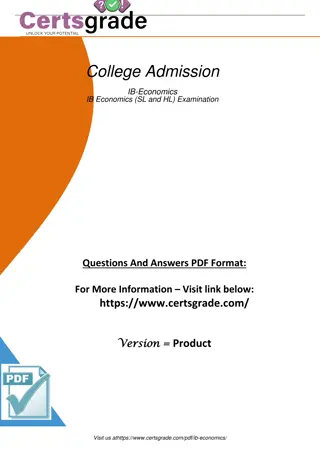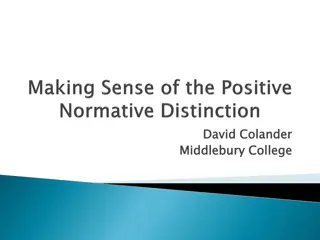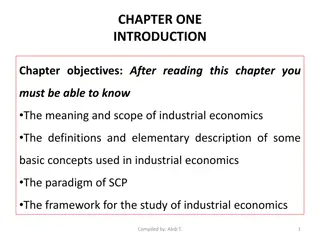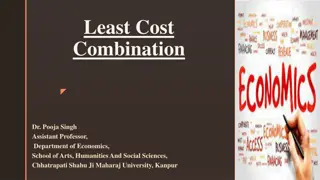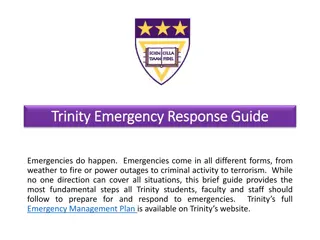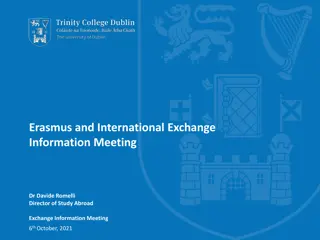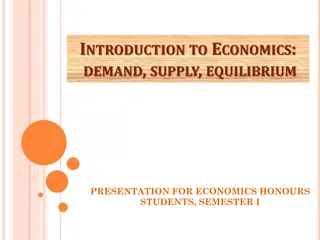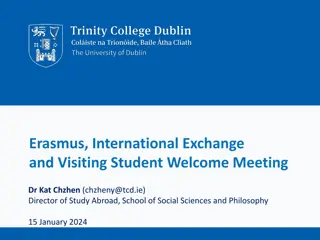Understanding the Impossible Trinity in International Economics
The Impossible Trinity in international economics posits that it is impossible to maintain a fixed exchange rate, free capital movement, and an independent monetary policy simultaneously. The story of Ashutosh illustrates this trilemma, where he faces a dilemma in choosing between traditional expectations and personal desires in his relationships. This economic concept mirrors the complexities faced in personal decision-making, highlighting the inherent trade-offs in prioritizing conflicting goals.
Download Presentation

Please find below an Image/Link to download the presentation.
The content on the website is provided AS IS for your information and personal use only. It may not be sold, licensed, or shared on other websites without obtaining consent from the author. Download presentation by click this link. If you encounter any issues during the download, it is possible that the publisher has removed the file from their server.
E N D
Presentation Transcript
FED TAPERING IMPOSSIBLE TRINITY
IMPOSSIBLE TRINITY The Impossible trinity is a trilemma (difficult choice from three options) in international economics which states that it is impossible to have all three of the following at the same time: A fixed exchange rate. Free capital movement (absence of capital controls). An independent monetary policy.
IMPOSSIBLE TRINITY Let us understand the impossible trinity by way of a story.
IMPOSSIBLE TRINITY Ashutosh is a young man in his late 20s who belongs to a not so rich family. His parents have taken a lot of pain to provide him all that he needed to become a successful person. He was never denied anything - whether it was clothes, bikes, education, money etc.
IMPOSSIBLE TRINITY His parents did everything and beyond for their son. There was no way in which Ashutosh would be able to pay off the debts he owed his parents. After all how much can you value such selfless sacrifice?
IMPOSSIBLE TRINITY Being young and eligible, Ashutosh s parents are keen to get him married to a girl from their community.
IMPOSSIBLE TRINITY And here comes the twist in the tale. Ashutosh is in love with a girl from his office. She is beautiful, educated, fantastic performer and more importantly she too loves Ashutosh. She seems to be the perfect match for Ashutosh according to all his friends.
IMPOSSIBLE TRINITY However, Ashutosh has not yet revealed his fondness for this girl to his parents. Since his parents have obliged him in the past by granting him all his wishes, he believes that they would accept Reena without batting an eyelid.
IMPOSSIBLE TRINITY Finally the day arrives when Ashutosh makes up his mind to talk to his parents about his lady love Reena. To his utter dismay his parents are aghast at his temerity.
IMPOSSIBLE TRINITY How could Ashutosh select a girl outside their community? How dare he steal their right of making this choice? How could he overlook their point of view? How could they stay with her? Would she even stay with them?
IMPOSSIBLE TRINITY This single announcement by Ashutosh was enough to bring the house down. The situation at home goes out of hand leaving Ashutosh in a state of turmoil. He is now in a big fix. Should he let go off his lady love, his lucky charm, his future ticket to a new world. Or should he toe the line of his parents.
IMPOSSIBLE TRINITY While he is still contemplating what needs to be done, his father drops another bombshell. He tells Ashutosh that he is burdened with enormous debt as the expenses that were made for Ashutosh during his growing up years swelled year by year.
IMPOSSIBLE TRINITY Now it was getting unwieldy to manage the debt. The father of the girl who they had selected has promised to pay off their debt. This would have eased his burden at this ripe old age and he could die in peace without the burden getting transmitted to his mother.
IMPOSSIBLE TRINITY The matter was getting more and more complicated now. First it was a dilemma between making one party happy - Parents or Sweetheart. Now this third dimension just opened up - The curse of debt for which he found himself responsible. The dilemma had transformed into a trilemma.
IMPOSSIBLE TRINITY This story explains the trilemma before the RBI governor when he was to announce the monetary policy due to the rupee slipping and losing value.
IMPOSSIBLE TRINITY The governor was compelled to raise interest rates and go against the market expectation of reducing interest rates and encouraging growth which of late had slowed down dramatically.
IMPOSSIBLE TRINITY At the beginning of 2013-14, the scenario was favorable for reducing interest rates because of the following reasons:- Inflation under control Comfortable foreign inflows Picking up of Reforms in FDI, and Rupee around Rs. 54 per dollar
IMPOSSIBLE TRINITY Accordingly, the RBI had started to ease the monetary policy to bring back growth and investment.
IMPOSSIBLE TRINITY But, unfortunately since mid-June 2013, emerging markets including India saw huge sell-off by FIIs adversely affecting our exchange reserves.
IMPOSSIBLE TRINITY India s balance of payments position was getting more and more vulnerable. This resulted in a sharp depreciation of the rupee to Rs. 65 per dollar and the march towards the bottom has perhaps not abated as yet.
IMPOSSIBLE TRINITY A weakening rupee is a lead indicator for inflation and hence with the potential threat of rising inflation again, the RBI had to take the unpleasant decision of raising interest rates and hurting growth in the bargain.
IMPOSSIBLE TRINITY This became an impossible trinity or trilemma for RBI. The dilemma initially was between inflation and growth. All of a sudden there was a new demon on the front door called rupee depreciation.
IMPOSSIBLE TRINITY Hope the above explanation would have given you an idea of the trilemma of RBI.
For more lessons visit www.tatamutualfund.com Please give us your feedback at professor@tataamc.com
DISCLAIMER The views expressed in this lesson are for information purposes only and do not construe to be any investment, legal or taxation advice. The lesson is a conceptual representation and may not include several nuances that are associated and vital. The purpose of this lesson is to clarify the basics of the concept so that readers at large can relate and thereby take more interest in the product / concept. In a nutshell, Professor Simply Simple lessons should be seen from the perspective of it being a primer on financial concepts. The contents are topical in nature and held true at the time of creation of the lesson. This is not indicative of future market trends, nor is Tata Asset Management Ltd. attempting to predict the same. Reprinting any part of this material will be at your own risk. Tata Asset Management Ltd. will not be liable for the consequences of such action. Mutual Fund investments are subject to market risks, read all scheme related documents carefully.


![❤Book⚡[PDF]✔ Doing the Impossible: George E. Mueller and the Management of NASA’](/thumb/21684/book-pdf-doing-the-impossible-george-e-mueller-and-the-management-of-nasa.jpg)





